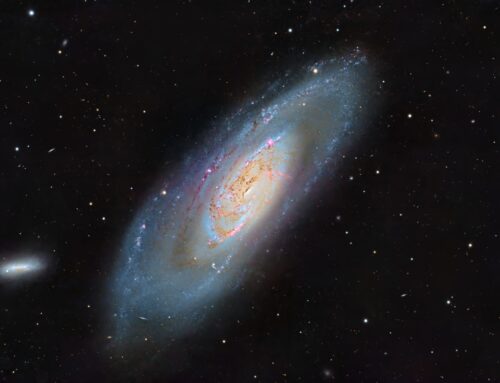van den Bergh 152 and Barnard 175
Click image for full size version
August 16, 2020
van den Bergh 152 (vdB 152; a.k.a. Cederblad 201) is the prominent blue reflection nebula on the right side of this image. It lies at the end of Barnard 175, the pillar of dust filling this field. The dark area connected to vdB is a Bok globule, a dense accumulation of cosmic dust from which stars are often born. The whole complex lies in the direction of the constellation Cepheus, about 1400 light years away and spanning 7 light years. Interestingly, the bright star illuminating vdB 152 was likely not born within this complex as it is moving through space at a different speed than the nebula.
Tekkies:
Sky-Watcher Esprit 150 f/7 refractor, and QHY 16200-A camera with Optolong LRGB filters. Acquisition, focusing, and control of Paramount MX mount, unguided, with TheSkyX. Focus with Optec DirectSync motor and controller. Automation with CCDCommander. Equipment control with PrimaLuce Labs Eagle 3 Pro computer. All pre-processing and processing in PixInsight. Acquired from my SkyShed in Guelph. Average or better transparency and seeing. Data acquired June 25-July 1, 2020 in a moderately moonlit sky.
90x5m L, 36x5m R, and 22x5m G and B (Total = 11hr10m)
Image scale 1.15 arcsec per pixel
Data Reduction and Cleanup
The BatchPreProcessing script was used to perform calibration, cosmetic correction and registration of all frames. ImageIntegration was used to make the L, R, G and B masters. DynamicCrop was used to crop all the masters identically. DynamicBackgroundExtraction was applied to each master twice, with Division followed by Subtraction.
RGB
Creation and cleanup: The R, G and B were combined to make an RGB image which was colour balanced with PhotometricColorCalibration.
Linear Noise Reduction: MultiscaleLinearTransform was used to reduce noise in the RGB image. Layer settings for threshold and strength: Layer 1: 4.0 0.8 Layer 2: 3, 0.7 Layer 3: 2., 0.6 Layer 4: 1.0, 0.2 Layer 5: 0.5, 0.1.
Stretching: HistogramTransformation was applied to make a pleasing, bright image, with background set to an intensity of approximately 0.10.
SuperLuminance
SuperLuminance: A synthetic luminance was made by combining L,R,G and B (weighted average in ImageIntegration) each DBE-processed channel.
Linear Noise Reduction: MultiscaleLinearTransform was used to reduce noise in the background areas, using an internal mask to protect bright structures. Layer settings for threshold and strength: Layer 1: 3.0 0.9 Layer 2: 2.0, 0.75 Layer 3: 1.0, 0.6 Layer 4: 0.5, 0.2.
Stretching: HistogramTransformation was applied to make a pleasing, bright image, with background set to an intensity of approximately 0.10.
Combining SuperLuminance and RGB
LRGB Combination: The SuperL was applied to the RGB image using LRGBCombine with default settings.
Additional Processing
Nonlinear Noise Reduction: TGVDenoise was used in L*a*b* mode to reduce noise with a mask used to mainly target the background areas and protect the stars (max. 1000 iterations and convergence selected for both lightness and chrominance).
Final Steps: Background, nebula, dark nebula and star brightness, contrast and saturation were adjusted in several iterations using CurvesTransformation with masks as required. The DarkStructureEnhance script was applied. ICCProfileTransformation (sRGB IEC61966-2.1; Relative Colorimetric with black point compensation) was applied prior to saving in jpg format.







Leave A Comment